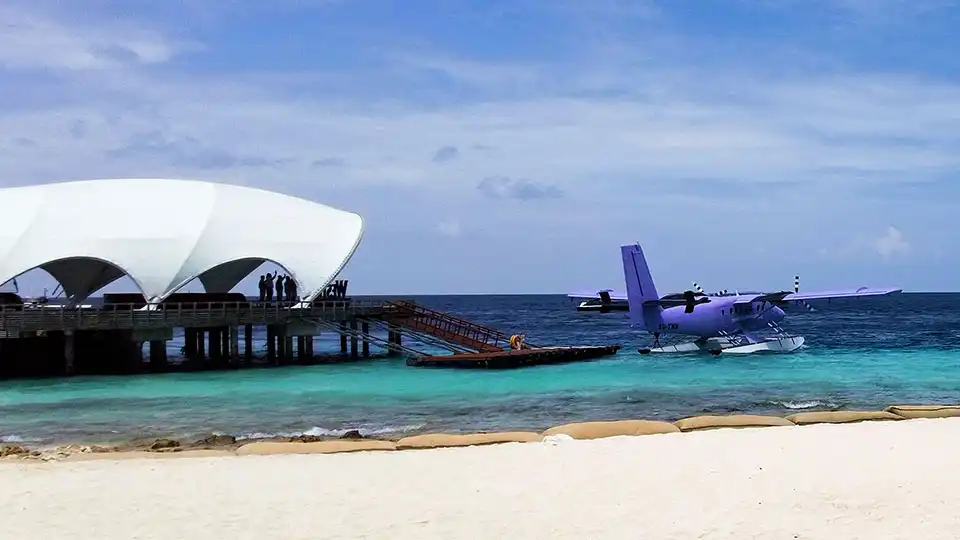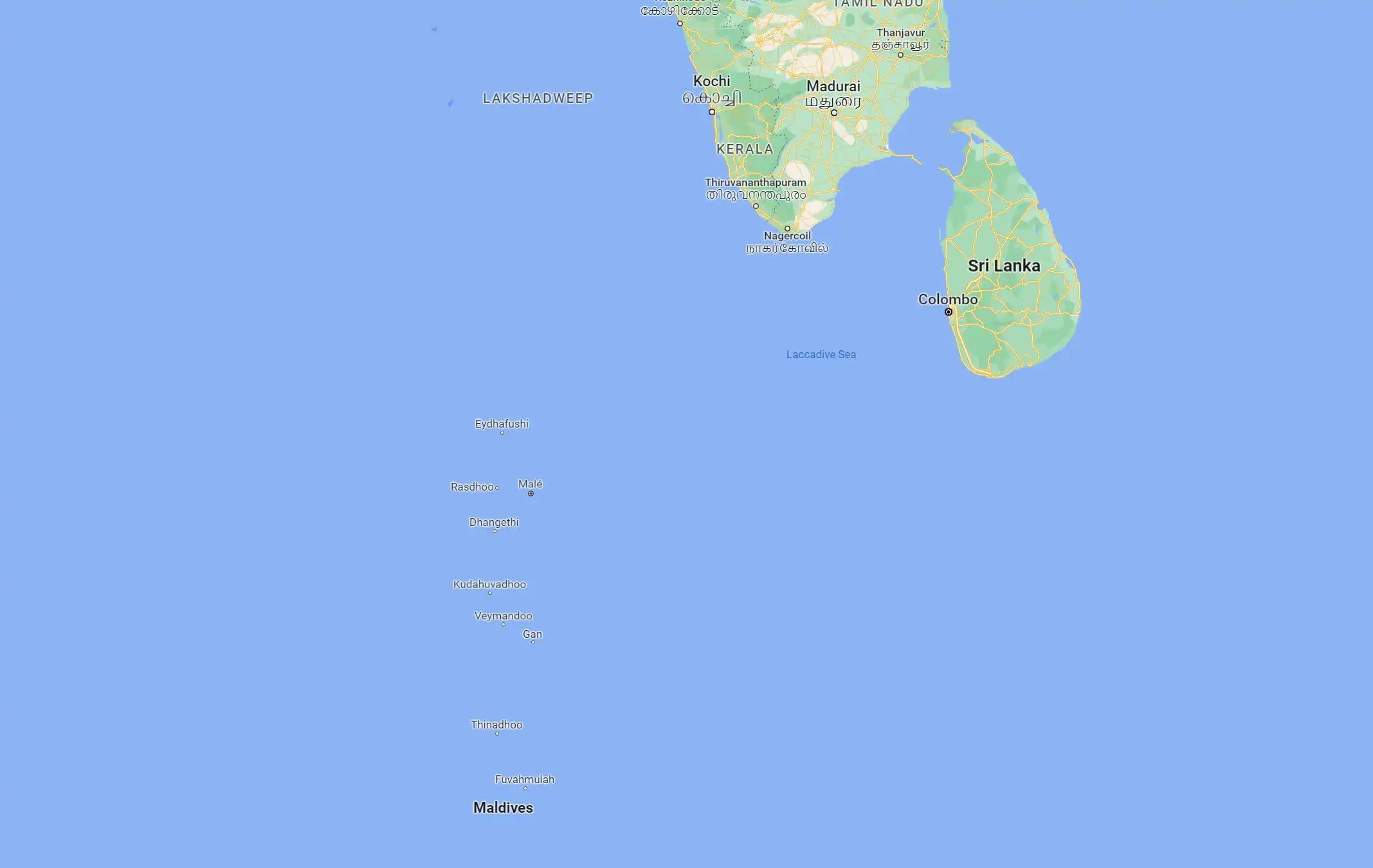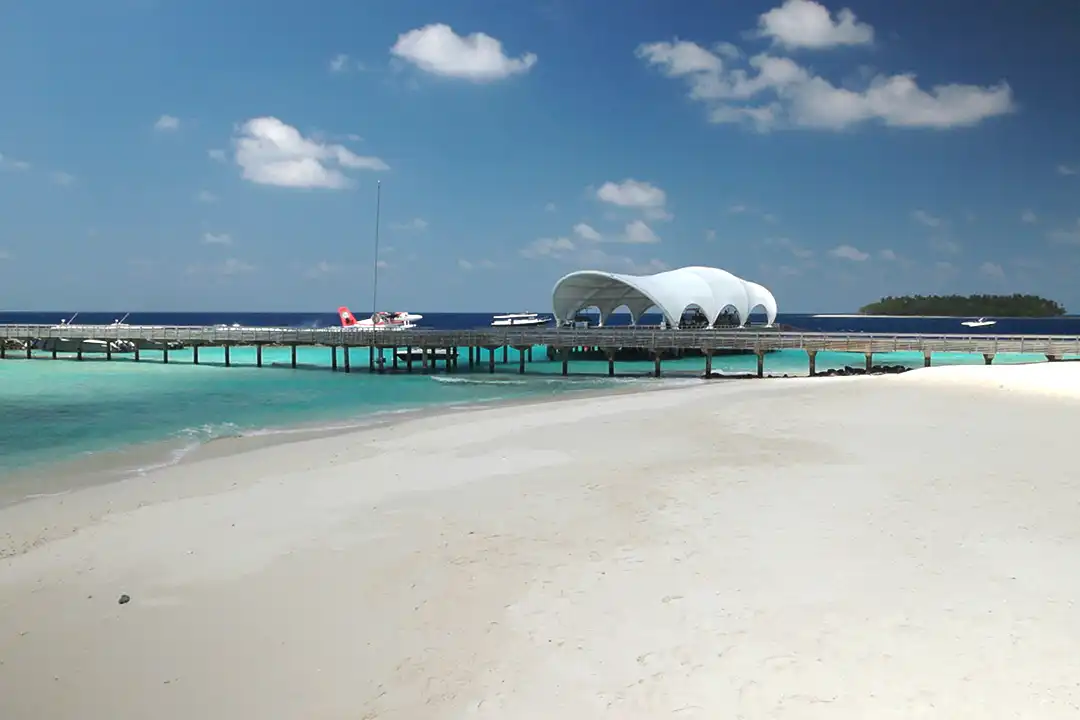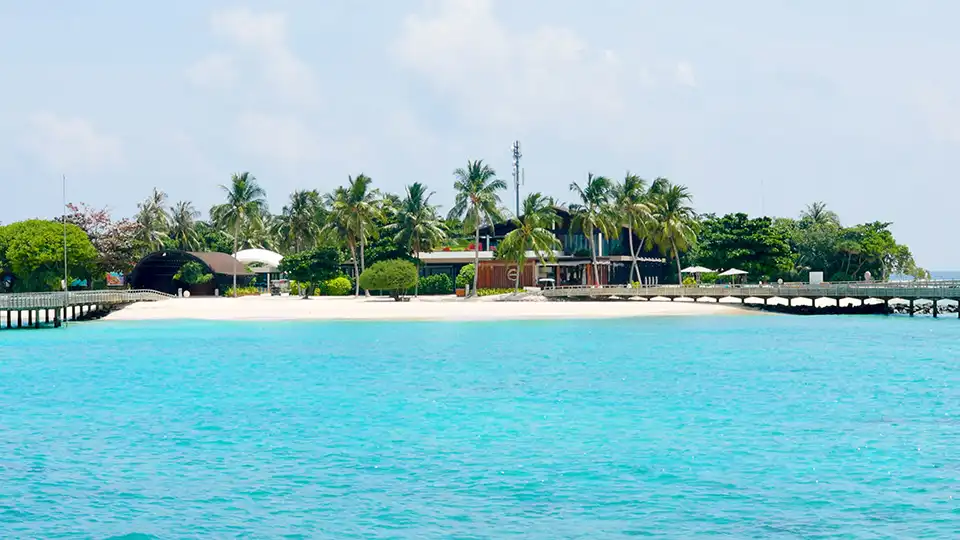The Maldives
An idyllic paradise in the Indian Ocean

Seaplane at a Resort Jetty
Introducing The Maldives
The Maldives conjures up images of beautiful white sand beaches, tropical palms and idyllic weather. Well its all true, and more! Fantastic snorkelling and diving, luxurious resorts and romantic meals await in the Maldives, but beware, it comes at a hefty price. As an example of these luxury options, check our our resort rteview of the Westin Miriandhoo resort on our hotels page.There are local options, but it is a much different experience. We'll show you the high–end resorts here, but if you're adventurous you can also catch local ferries between the islands and stay at local places. It's still paradise...
The Maldives is a tropical island nation located in the Indian Ocean, southwest of India and Sri Lanka. It is made up of a chain of 26 atolls, which consist of more than 1,000 coral islands. The capital city is Malé, which is located on the island of the same name.
The Maldives is known for its beautiful beaches, crystal-clear waters, and diverse marine life, making it a popular destination for tourists from around the world. It is also known for its luxury resorts, which are often built on private islands and offer a range of activities, such as snorkeling, scuba diving, and surfing.
The official language of the Maldives is Dhivehi, but English is widely spoken and understood. Islam is the official religion, and the majority of the population is Sunni Muslim.
The Maldives has a population of around 540,000 people, and its economy is heavily dependent on tourism and fishing. The country has a low-lying geography, with its highest point only reaching 2.4 meters above sea level, which makes it particularly vulnerable to the effects of climate change and rising sea levels.
The Maldives is known for its vibrant culture, which is a blend of South Asian, Arab, and East African influences. The country has a rich history and tradition of art, music, and dance, which can be seen in its festivals and celebrations.
For better or worse though, visitors are not likely to meet many locals. There are regulations prohibiting locals from visiting resort islands unless they are emplyed there, and not many visitors venture to the local islands and atolls, which is a pity. It is easy to visit the capital of Malé though, and if you get the chance it can be a rewarding experience. We stayed at the Samann Grand Hotel in the city, which was acceptable, albeit a little expensive for what it was.
Some History
The Maldives has a rich and complex history that dates back over 2,500 years. The earliest settlers of the Maldives were likely people from South India and Sri Lanka who brought Buddhism to the islands. In early medieval times they followed the Sri Lankan type of Buddhism, but in AD1153 were converted to Islam by order of their ruler King Dhovemi. Over time, the Maldives became an important trading hub for Arab and East African merchants, who introduced Islam to the islands in the 12th century.
In the 16th century, the Maldives became a protectorate of the Portuguese, who established a presence on the islands and introduced Christianity. However, the Maldivian people rebelled against Portuguese rule, and in 1573 they expelled the Portuguese and established a sultanate.
The Maldives continued to be ruled by a succession of sultans until the 20th century, when it became a British protectorate in 1887. The country gained independence from Britain in 1965, and in 1968 it became a republic.
In 1978, Maumoon Abdul Gayoom became president of the Maldives, and he would go on to hold that position for 30 years, making him one of the longest-serving leaders in the world. During his presidency, Gayoom oversaw the modernization of the Maldives, including the development of the tourism industry.
In 2008, the Maldives held its first democratic presidential election, which was won by Mohamed Nasheed. However, Nasheed's presidency was cut short in 2012 when he was forced to resign in a coup. The current president of the Maldives is Ibrahim Mohamed Solih, who was elected in 2018.
Throughout its history, the Maldives has faced numerous challenges, including piracy and climate change. Today, the country remains a vibrant and dynamic nation, known for its beautiful beaches, vibrant culture, and commitment to sustainability.
About The Area
The Maldives is the world's lowest-lying country, with an average elevation of just 1.5 meters above sea level. Its highest point is Villingili Island, which reaches a height of 2.4 meters. Due to its low-lying geography, the Maldives is particularly vulnerable to the effects of climate change and rising sea levels.
The Maldives has a tropical climate, with temperatures ranging from 25 to 32 degrees Celsius year-round. The country is known for its beautiful beaches, crystal-clear waters, and diverse marine life, which make it a popular destination for tourists from around the world. The coral reefs surrounding the islands are home to a wide variety of marine species, including sharks, rays, turtles, and colorful fish.
The Maldives is divided into 20 administrative atolls, each of which is made up of a number of inhabited and uninhabited islands. The capital city, Malé, is located on the island of the same name and is home to more than a third of the country's population.
Overall, the geography of the Maldives is characterized by its unique island chain, low-lying elevation, and stunning natural beauty.

When to Go
The best time to visit the Maldives is between November and April, during the dry season. This is when the weather is at its best, with plenty of sunshine, blue skies, and low humidity. The seas are also calm, making it the perfect time for swimming, snorkeling, and diving.
It's worth noting that the months of December to February are considered the peak tourist season, so if you plan to travel during this time, be prepared for higher prices and larger crowds. However, the weather during this time is simply spectacular, and you'll be rewarded with picture-perfect scenery and plenty of opportunities to soak up the sun.
The monsoon season in the Maldives runs from May to October, with the wettest months being June and July. During this time, there is a higher chance of rain, and the seas can be rougher. However, some travelers prefer visiting the Maldives during the monsoon season for the lower prices and fewer tourists.
Ultimately, the best time to visit the Maldives depends on your preferences and budget. If you're looking to experience the best weather and don't mind paying a premium for it, the dry season is the ideal time to visit. On the other hand, if you're on a tight budget and don't mind a bit of rain, the monsoon season might be a good option for you.
The People
The Maldives has a population of approximately 550,000 people, with the majority living in urban areas. The people of the Maldives are known as Maldivians or Dhivehin. The Maldivian population is a mix of various ethnic groups, including South and Southeast Asians, Arabs, and Africans.
The Maldivian society is largely homogenous, with a shared culture and language. The official language is Dhivehi, which is closely related to the Sinhalese language spoken in Sri Lanka. English is also widely spoken, particularly in the tourism industry.
The Maldivian people are predominantly Sunni Muslim, with Islam being the official religion of the country. The practice of other religions is not permitted, and non-Muslims are not allowed to become citizens of the country.
The Maldives has a relatively high literacy rate, with education being free and compulsory for children between the ages of 6 and 16. The country has a well-developed education system, with schools and colleges located on most of the inhabited islands. The literacy rate among the adult population is estimated to be over 98%.
The Maldivian people are known for their warm hospitality and friendly nature. They take great pride in their country and culture, and are happy to share their traditions and customs with visitors. The Maldives is a multicultural society that values diversity and tolerance, making it a welcoming and inclusive destination for travelers from all over the world.
The Cuisine
The cuisine of the Maldives is heavily influenced by Indian, Sri Lankan, and Arabic cuisine. Seafood, particularly tuna, is a staple of the Maldivian diet, as the country is surrounded by the Indian Ocean. Coconut, starches, and vegetables are also commonly used in Maldivian cooking.
A popular Maldivian dish is Garudhiya, a clear fish broth made with tuna and served with rice, lime, chili, and onions. Another well-known dish is Mas huni, a salad made with shredded smoked tuna, grated coconut, and onions, served with flatbread.
Rihaakuru, a thick paste made from boiled tuna and coconut, is another popular ingredient in Maldivian cooking. It is used as a base for many dishes, including curries and stews.
Coconut is also used in many Maldivian desserts, such as Bajiya, a deep-fried pastry filled with sweetened coconut and cardamom. Huni hakuru folhi, a dessert made with coconut, jaggery, and rice flour, is another popular sweet treat.
Due to its popularity as a tourist destination, the Maldives also offers a variety of international cuisine, including Italian, Chinese, and Japanese. However, for a truly authentic experience, visitors should try some of the local Maldivian dishes, which offer a unique blend of flavors and spices.
Things To Do
Sights
Most of the activities in the Maldives center around the high end 5 star resorts, although there are opportunities for independent travel.
There are plenty of activities to enjoy in the Maldives, both on land and in the water. Here are some examples:
- Snorkeling and Diving: With crystal clear waters and diverse marine life, the Maldives is a paradise for snorkelers and divers. Many resorts offer snorkeling and diving excursions, as well as courses for beginners.
- Water Sports: The Maldives offers a range of water sports, including kayaking, jet skiing, windsurfing, and parasailing. Some resorts also have their own water sports centers where you can rent equipment or take lessons.
- Island Hopping: The Maldives is made up of over 1,000 islands, each with its own unique charm. You can take a day trip or a multi-day excursion to explore different islands, experience local culture, and enjoy stunning scenery.
- Spa Treatments: The Maldives is known for its luxurious spas, which offer a range of treatments, from traditional Maldivian massages to Ayurvedic therapies.
- Sunset Cruise: Watching the sun set over the Indian Ocean is a breathtaking experience. You can take a sunset cruise on a traditional Maldivian boat, known as a dhoni, and enjoy the stunning views with a drink in hand.
- Cultural Activities: The Maldives has a rich history and culture, which you can experience through various activities, such as visiting local villages, attending traditional dance and music performances, or learning about the country's handicrafts and traditions.
- Yoga and Wellness: Many resorts in the Maldives offer yoga and meditation classes, as well as wellness programs that focus on health, nutrition, and mindfulness.
Seaplanes are used by visitors to travel between the islands. Locals often use ferries, which may also be available to visitors

Hotel Reception at the Seaplane Pier. Most resorts are reached by seaplane
Places to Stay
Top End Hotels & Resorts
- Soneva Fushi: Located in the Baa Atoll, Soneva Fushi is a luxury resort that offers villas with private pools, a spa, and multiple dining options.
- Four Seasons Resort Maldives at Landaa Giraavaru: Situated in the Baa Atoll, this resort offers villas with private pools and outdoor showers, a spa, and a range of activities, including snorkeling, diving, and tennis.
- The Westin Maldives Miriandhoo Resort is located on the Baa Atoll, which is known for its excellent diving and snorkeling opportunities, as well as its beautiful natural scenery. See YouTube Review
- St. Regis Maldives Vommuli Resort: This Bonvoy hotel is located in the Dhaalu Atoll and offers overwater and beach villas, as well as multiple dining options, a spa, and a range of activities, including snorkeling, diving, and water sports.
- Grand Hyatt Maldives: Located on the private island of Maafushi in the North Male Atoll, this luxury resort features 120 villas, including overwater villas, beachfront villas, and pool villas. The resort offers a range of dining options, a spa, a fitness center, and a variety of water sports and activities.
- Park Hyatt Maldives Hadahaa: Situated on a private island in the North Huvadhoo Atoll, this eco-friendly resort offers 50 villas, including overwater villas, beach villas, and pool villas. The resort has two restaurants, a spa, a fitness center, and a variety of water sports and activities.
- Hyatt Regency Maldives: Located on the private island of Dhakuni in the South Male Atoll, this luxury resort features 166 villas, including overwater villas, beachfront villas, and pool villas. The resort offers a range of dining options, a spa, a fitness center, and a variety of water sports and activities.
- W Maldives: Also located in the North Ari Atoll, this Bonvoy hotel offers overwater and beach villas, multiple dining options, a spa, and a range of activities, including snorkeling, diving, and water sports.
- Gili Lankanfushi: Located in the North Malé Atoll, this resort offers overwater villas with private decks, a spa, and multiple dining options.
- Conrad Maldives Rangali Island: This resort is located on two private islands and offers a range of villas and overwater bungalows, as well as multiple restaurants, a spa, and a range of activities, including snorkeling and diving.
- JW Marriott Maldives Resort & Spa: This Bonvoy hotel is located in the Shaviyani Atoll and offers overwater and beach villas, as well as multiple dining options, a spa, and a range of activities, including snorkeling, diving, and water sports.
- Amilla Fushi: This resort is located in the Baa Atoll and offers villas with private pools, a spa, and a range of activities, including snorkeling, diving, and tennis.

The Westin Miriandhoo Resort in the Maldives
Many of the top hotels are located on private atolls, and require a seaplane transfer
Places to Stay
Mid Range Hotels - Malé
- The Somerset Hotel: A boutique hotel located in the heart of Male, The Somerset Hotel features 30 cozy rooms with modern amenities. The hotel offers a restaurant, a rooftop terrace, a fitness center, and a spa.
- The Beehive: A stylish hotel located a short walk from the beach and the ferry terminal, The Beehive offers 32 rooms with colorful decor and contemporary amenities. The hotel features a restaurant, a rooftop terrace, and a 24-hour front desk.
- The Avenue Hotel: A modern hotel situated in the business district of Male, The Avenue Hotel features 21 well-appointed rooms with sleek decor and modern amenities. The hotel offers a restaurant, a rooftop terrace, and a fitness center.
- The Vinorva Maldives: A cozy hotel located in a residential area of Male, The Vinorva Maldives features 16 comfortable rooms with modern amenities. The hotel offers a restaurant, a rooftop terrace, and a 24-hour front desk.
- Samann Grand: Located in the heart of Male, the Samann Grand is a modern hotel that features 38 well-appointed rooms with contemporary amenities. The hotel offers a restaurant, a rooftop terrace, and a fitness center.
Mid Range Hotels - Other Islands
- Fatma Guesthouse in Maafushi: Maafushi is a popular local island that is known for its beautiful beaches and water activities. The Fatma Guesthouse is a cozy hotel that offers 10 comfortable rooms with modern amenities. The hotel is located just a few minutes' walk from the beach, and it features a restaurant and a 24-hour front desk.
- Thoddoo Beach View in Thoddoo Island: Thoddoo Island is known for its agriculture, especially its watermelon production, as well as its beautiful beaches. The Thoddoo Beach View is a mid-range hotel that features 8 comfortable rooms with modern amenities. The hotel is located just a short walk from the beach, and it offers a restaurant and a garden.
- Gulhi Beach Villa in Gulhi Island: Gulhi Island is a small local island that is known for its laid-back vibe and beautiful beaches. The Gulhi Beach Villa is a cozy hotel that features 8 comfortable rooms with modern amenities. The hotel is located just a few steps from the beach, and it offers a restaurant and a terrace.
- Beachwood Hotel and Spa in Maalhos Island: Maalhos Island is a secluded island that is known for its peaceful atmosphere and marine life. The Beachwood Hotel and Spa is a mid-range hotel that features 15 comfortable rooms with modern amenities. The hotel is located just a short walk from the beach, and it offers a restaurant, a spa, and a garden.
Book Accomodation Through booking.com
Getting There & Getting Away
Air
The only practical means of getting to the Maldives is by flying. Although private yachts and other maritime options may exist, they are outside of the scope of this guide. All international airlines that fly to the Maldives do so through Malé International Airport
Major airlines that fly to Malé include:
- Emirates: Dubai
- Qatar Airways: Doha
- Etihad Airways: Abu Dhabi
- Turkish Airlines: Istanbul
- Singapore Airlines: Singapore
- SriLankan Airlines: Colombo
- Air India: Delhi, Mumbai, Bangalore,Thiruvananthapuram
- Thai Airways: Bangkok
- Malaysia Airlines: Kuala Lumpur
- British Airways: London
- Air France: Paris
- Lufthansa: Frankfurt
- Cathay Pacific: Hong Kong
- China Eastern Airlines: Shanghai
- Korean Air: Seoul
- Oman Air: Muscat
Getting Around
In the Maldives, the most common methods of local transport include:
- Ferries: Ferries are widely used for inter-island travel. Public ferries connect Male, the capital, with other inhabited islands, and they are an affordable option for both locals and tourists. There are also speedboats and private ferries available for faster and more convenient transportation. As a tourist or traveller, ferries and speedboats will be your most common form of transport.
- Seaplanes:Seaplanes are the most common way to get to the resorts within the Maldives. The transfer to the seaplane terminal is usually included in the cost of the seaplane ticket. The seaplanes are quite expensive, but a lot of fun. Trans-Maldivian Airways are the largest operator of seaplanes in the world, and are known as the Barefoot Airline
- Taxis: Taxis are commonly available in urban areas like Male and larger tourist resorts. Taxis can be hailed on the streets or arranged through your accommodation. They are a convenient way to travel within a city or for shorter distances.
- Buses: Public buses operate in Male and some of the larger inhabited islands. They are an economical way to get around the city or travel between different areas. In Male, the bus system is well-organized with designated routes and stops.
- Motorcycles and Bicycles: In some islands, especially smaller ones, motorcycles and bicycles are popular modes of transportation. They can be rented from local rental shops and provide flexibility for exploring the island at your own pace.
- Walking: Many islands, particularly the smaller ones, are easily navigable on foot. Walking is a pleasant way to explore the local surroundings, especially in areas with narrow streets and limited vehicle access.
Emergency Contacts
These emergency services contact numbers are important to know while you are in the Maldives.
- Police - 119
- Medical Emergency - 102
- Fire and Rescue - 118
- Maldives National Defense Force (MNDF) Coast Guard - 191
- Tourist Police - 119
Summary
The Maldives is a tropical paradise in the Indian Ocean, renowned for its stunning natural beauty, pristine white-sand beaches, crystal-clear turquoise waters, and vibrant marine life. It is a popular tourist destination for several reasons:
- Breathtaking Beaches and Islands: The Maldives is home to some of the most beautiful beaches in the world. The islands offer secluded and serene settings, where you can relax, sunbathe, and indulge in water activities.
- World-Class Snorkeling and Diving: The Maldives boasts incredible coral reefs and diverse marine life. Snorkeling and diving enthusiasts can explore colorful coral gardens, swim alongside exotic fish, and even encounter majestic manta rays and whale sharks.
- Luxurious Resorts and Overwater Villas: The Maldives is renowned for its luxury resorts and iconic overwater villas. Staying in these lavish accommodations allows you to enjoy privacy, direct access to the ocean, and breathtaking views.
- Water Sports and Activities: From kayaking and paddleboarding to jet skiing and windsurfing, the Maldives offers a wide range of water sports and activities. Whether you are seeking adrenaline-pumping adventures or simply want to enjoy the serenity of the ocean, there's something for everyone.
- Unspoiled Natural Beauty: The Maldives is an archipelago of islands, many of which remain untouched and pristine. The natural beauty of the islands, with their lush greenery, coconut palm trees, and idyllic landscapes, provides a tranquil and picturesque escape from the bustling city life.
- Exquisite Cuisine: The Maldivian cuisine is a delightful blend of flavors influenced by Indian, Sri Lankan, and Arabian culinary traditions. Indulge in fresh seafood, aromatic spices, and tropical fruits, and savor the unique dining experiences offered by the resorts.
- Romantic Getaway: The Maldives is often regarded as a romantic destination, ideal for honeymooners and couples seeking a dreamy escape. The serene ambiance, intimate settings, and spectacular sunsets create an unforgettable romantic atmosphere.
Overall, the Maldives offers a perfect combination of natural beauty, luxury, relaxation, and adventure. Whether you seek a romantic getaway, an underwater exploration, or simply wish to unwind on pristine beaches, the Maldives promises an unforgettable experience in a tropical paradise.
Copyright © 2025 travel-with-mark.com. All rights reserved. No part of this website or any of its contents may be reproduced, copied, modified or adapted, without the prior written consent of the owner, unless otherwise indicated for stand-alone materials. Unauthorized use is strictly prohibited. All trademarks, service marks, and trade names used in this website are the property of their respective owners and are used for identification purposes only. Your access to and use of this website is subject to our terms and conditions. Details of our privacy practices may be found in our privacy notices